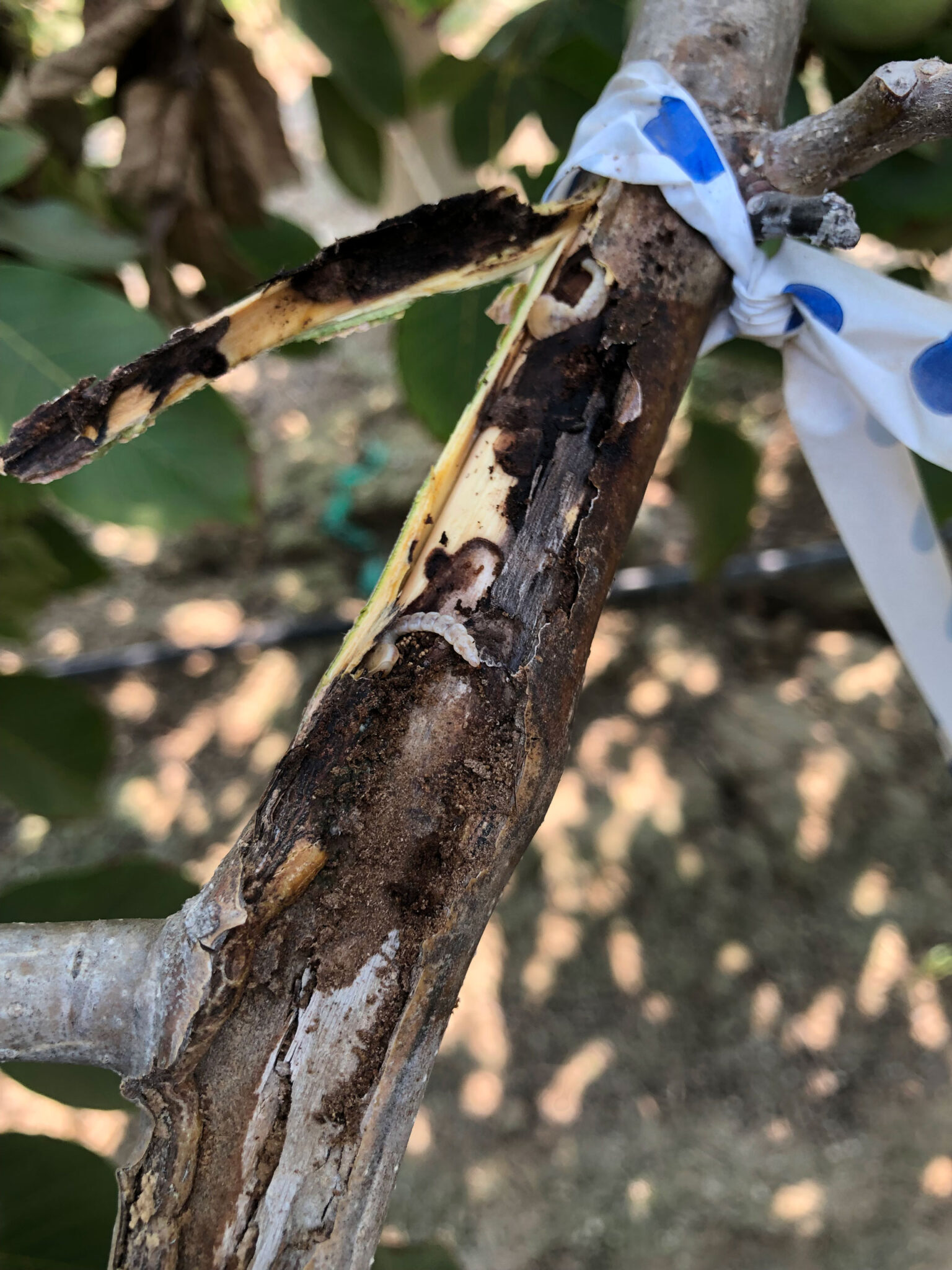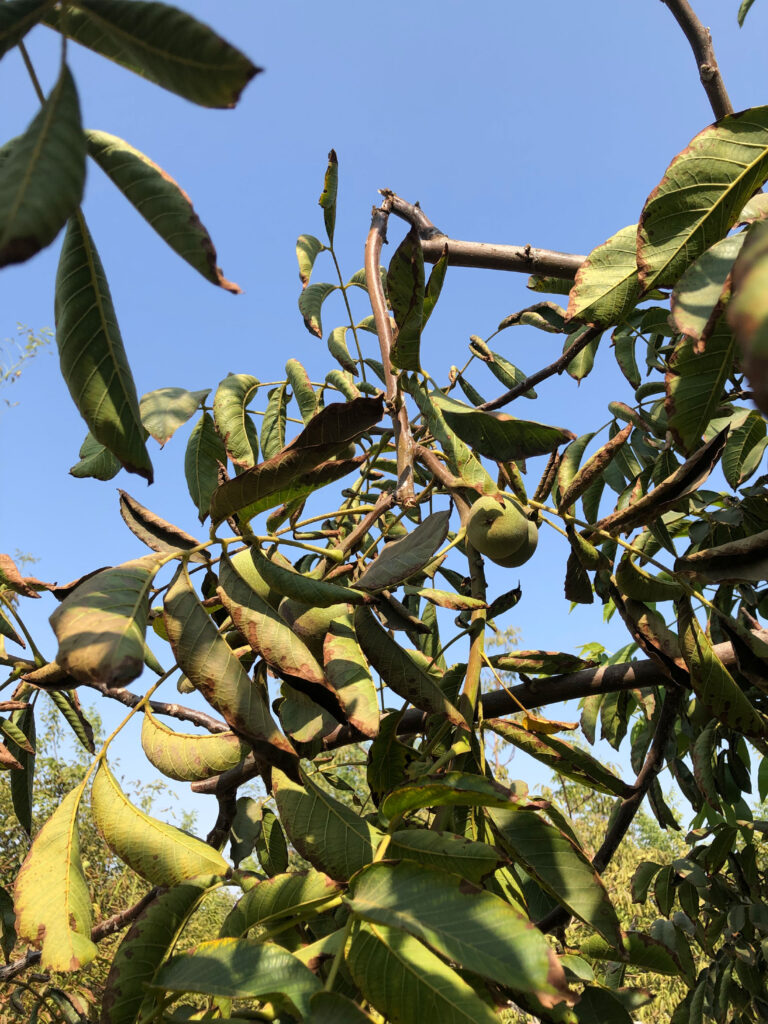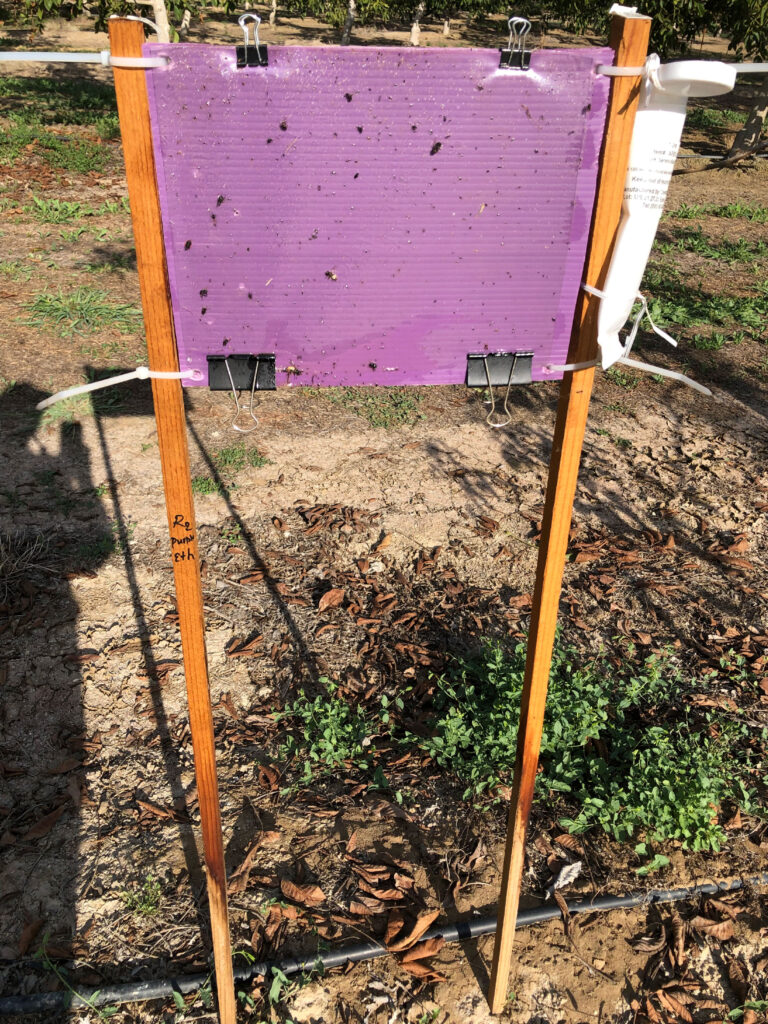
In the summer of 2018, UCCE IPM Advisor Jhalendra Rijal had his first direct encounter with Pacific flatheaded borer.
“Some growers were reporting damage in walnuts,” he said. “We went out there, found larvae and later figured out it was flatheaded borer.”
While not new to California agriculture, the Pacific flatheaded borer today is a significant pest of walnuts, particularly, but not exclusively, to young walnut orchards. In some cases, damage from the pest has approached 100%, Rijal said.
In one case, Rijal noted, a grower ended up cutting every tree in his one-year-old orchard beneath the infestation points and re-budding them because of damage from the pest. “So, you can imagine the cost,” Rijal said. “First, there is the money for labor and material investment, but the grower also was two years late coming into production.”
The pest also has emerged in recent years as a significant issue in Oregon hazelnuts.

“In 2016, we started seeing a lot of damage in young hazelnut orchards from the borer,” said Oregon State University Extension Hazelnut Specialist Nik Wiman. “Before then, it was pretty much unrecognized.”
Wiman said the pest appears to have come into hazelnuts from outside of orchards in 2015 when drought stress exposed young trees to the pest. A year later, the damage started showing up.
“It was pretty devastating in some orchards,” he said. “We saw losses topping 30% in certain orchards, and there was even a cherry orchard that was 100% damaged. They just ripped it out and had to replant it.
“It can be really destructive,” Wiman said.
Wide Host Range
The Pacific flatheaded borer, Chrysobothris mali, affects multiple tree crops in the Western U.S., including several tree fruits and some tree nuts. The pest is known to attack diseased or stressed trees.
“Drought, over-irrigation or poor soil conditions, all of those can be predisposing factors,” Rijal said.
Flathead borer adults lay eggs in branches with cracks and wounds, and larvae slowly move into the wood by feeding on the cambium layer of the infested branch first, he said.
The pest also likes branches exposed to sun. “They like the warmth of the branches and twigs and lay their eggs there,” Rijal said.
Rijal noted that researchers don’t know why the pest has suddenly appeared as a significant problem in walnuts. He and others speculate that the dry conditions and drought that have permeated the Central Valley as of late is a contributing factor, as well as the increase in walnut acres.
“Plus, I would say that growers are much more aware of this pest now and finding more because of that,” he said.
Rijal added that in recent years, the pest appears to be attacking older, more mature trees, a divergence from its historical range, and another potential reason for why it has become more recognized as a pest of concern.
“Not only are the young trees, first- and second-year trees infested on the trunk, but we are now seeing bigger limbs and smaller branches, even pencil-sized branches, that have flatheaded borer infestations,” he said. “And even healthy-looking trees, four, six, seven, even ten-year-old optimally producing trees also are getting attacked now.”
The increased pressure has led to two research projects, one funded by the Walnut Board of California in 2019 and a new multi-state project started this summer that is funded by a USDA Specialty Crop Research Initiative grant and being led by Tennessee State University, where a similar flathead borer species is causing problems in nursery tree plants.
Researchers from other Eastern states, including Florida, Georgia, North Carolina and South Carolina are part of the grant, as well as Rijal and Wiman, who are looking at walnuts and hazelnuts in California and Oregon.
In the 2019 research project, Rijal was able to identify the species of flatheaded borer causing damage in walnuts, produce photographs of symptoms so growers know what to look for when scouting for the pest and get some preliminary data on the pest’s biology and behavior.
“We were able to do the preliminary work looking at the adult beetle emergence timing in the summer to understand the pest biology better. This helps to ultimately develop pest monitoring and management,” he said.
Monitoring Tools
As part of the USDA’s Specialty Crop Research Initiative project titled Flatheaded Borer Management in Tree Specialty Crops, researchers are looking at different monitoring tools, or traps and attractants, attempting to pinpoint peak adult emergence and looking at different insecticides with the hope of developing control strategies.
To date, preliminary research conducted in the northern San Joaquin Valley has shown peak adult emergence occurs in June. “Although emergence starts in May and can continue through July, we think that mid-June is the peak adult activity period, at least in the area where I am doing the work,” Rijal said.
Knowing peak adult emergence may potentially help pinpoint the optimum window for targeting young larvae with insecticides, he said.
To date, researchers recommend growers become familiar with symptoms and remove infected tree parts in fall or winter as well as coat trunks of young trees with white paint before they are exposed to sunlight.
Scouting in late summer/early fall will help growers identify damaged trees, Rijal said. “In the summer, you can see the brown frass at the infestation point on branches,” he said, “and at that point, you know that larva is inside because of that.”

He added that removing infected branches may not provide 100% control of the pest in the first year. “It is more like a population-reduction method,” he said. “You probably won’t be able to remove all the infested branches depending on the pressure, but it helps a lot, because you are essentially killing the larvae that are hiding inside the infested plant materials.”
Left alone, infected branches may not die immediately, he said, but over time they will succumb to the pest, and an infestation increases the likelihood a branch will break. “Even simple, regular wind will break it,” Rijal said.
Neonicotinoid insecticides, said as Imidacloprid, are effective at controlling the pest in hazelnuts, Wiman said. But those are under scrutiny by EPA and may not be available in future years.
A relatively new class of insecticide, diamides, also has shown efficacy on the pest in hazelnuts, but at this point isn’t labeled for use against it, Wiman said.
“Experimentally, we are showing it works,” he said. “So, if we lose the neonicotinoids, which we probably will eventually because they are already banned in Europe, at least we have some alternatives to go to.”
Rijal noted that in some cases, growers may be getting some residual control of the flatheaded borer through codling moth or navel orangeworm sprays, but how much of an effect is in question.
“The insecticides might have some impact on flatheaded borer, but we know that it is not enough because we are seeing infestations regardless of whether the grower had treated for codling moth or navel orangeworm,” he said.
He emphasized that painting young trees with white latex paint is a must. “That is a must practice, especially with the Central Valley heat,” he said. “Get that latex paint on at least before sunburn risk.”










